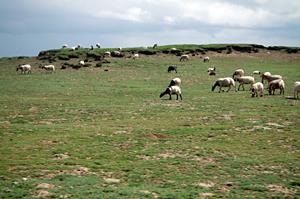
27 September 2011, Rome - The vast potential of grasslands to support sustainable livelihoods while trapping atmospheric carbon and helping slow down global warming is one step closer to being realized thanks to a new methodology developed by FAO in collaboration with the Chinese Academy of Agricultural Science, the Chinese Academy of Sciences and the World Agroforestry Centre.
Large swathes of the world's grasslands are moderately to severely degraded — restoring them to a healthy state could remove gigatonnes of carbon from the atmosphere and improve resilience to climate change.
So far, however, carbon crediting schemes that pay projects for reducing greenhouse gas (GHG) emissions and sequestering carbon have largely ignored agriculture, including grazing-based livlihood systems.
One key challenge has been finding reliable and affordable ways to measure how much carbon is being trapped in agricultural mitigation projects.
FAO's new Methodology for Sustainable Grassland Management could help overcome this obstacle.
"We think we have cracked the problem and come up with a reliable way for herders who are investing in restoring grasslands to prove they are sequestering measurable amounts of carbon, and fund their activities by accessing mitigation finance," said Pierre Gerber, an FAO livestock policy specialist who works on the project.
Measurement is the challenge
The breakthrough of FAO's new methodology is that it provides an affordable way to reliably estimate the amount of GHG emissions removed from the atmosphere through improved management of grasslands.
"Our approach allows not only for direct measurement of carbon sequestration through soil sampling but also computer modelling of sequestration based on soil types and activities undertaken," explained Leslie Lipper, an FAO economist involved in the project. "Being able to demonstrate reliable monitoring is a must for projects wishing to participate in carbon markets, and modelling reduces monitoring costs, making it possible for small-scale herders and livestock raisers to participate."
The methodology is being applied to a pilot project in Qinghai Province, China, which will eventually be able to deliver significant carbon offsets for a period of 10 years. After that point, the restored grasslands will have stored as much carbon as it is possible for them to do, and incomes from carbon trading will wind down. But the lands involved will have been brought back to full productivity and livestock systems will have shifted to a sustainable model capable of sustaining the livelihoods of herders for generations to come.
Carbon credits from restored grasslands
The Qinghai project started in 2008, when FAO, the World Agroforestry Centre, the Chinese Academy of Sciences and the Provincial Government began working with herders to jointly design improved grazing and land management practices which can restore soil health, improve milk and meat production and generate ecosystem services such as reducing run-off and flash floods and conserving biodiversity.
The end game, though, was to develop a cost-effective means of estimating and crediting the extent to which such practices result in GHG reductions via carbon sequestration in soils and reduced methane generation by animals, so herders can earn money from selling carbon offset credits on emission trading markets. This added income is key to helping overcoming the barriers herders face in restoring ecosystems — such as short-term reductions in livestock revenues.
Returns are invested in further restoring the long-term health of the lands upon which they depend and building up marketing associations to improve their profits from traditional animal raising.
"The project in China is just an example of what this methodology can do. It can readily be used in other places, and scaled up to achieve similar results in most degraded grasslands," said Gerber.
Opening the door to mitigation finance
FAO has just submitted its methodology for approval by the non-profit Verified Carbon Standard (VSC) a greenhouse gas accounting programme used by projects around the world to verify and issue carbon credits in emissions markets.
Once approved, any grassland project using the methodology will be eligible for the creation and trade of carbon credits in voluntary carbon markets throughout the world.
"And just as significantly, this methodology now gives countries a clear-cut option for including sustainable grassland management in their Nationally Appropriate Mitigation Actions (NAMAs) to reduce GHG emissions, which they are developing in line with national climate strategies and in light of the UNFCCC Cancun Agreements of last December," added Lipper. "So far, there have been few options for doing so".
FAO's work on the methodology was supported by the French development agency.